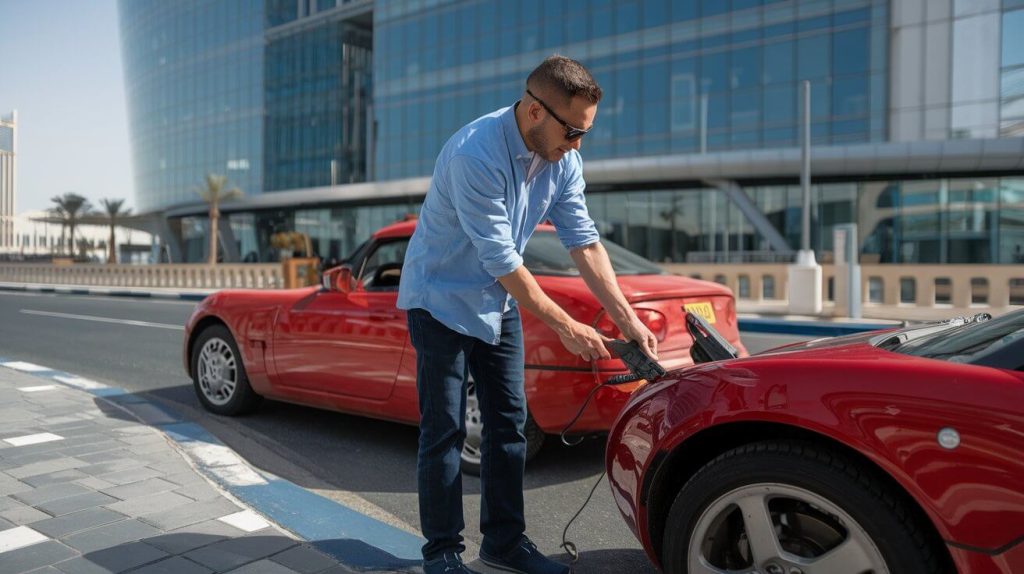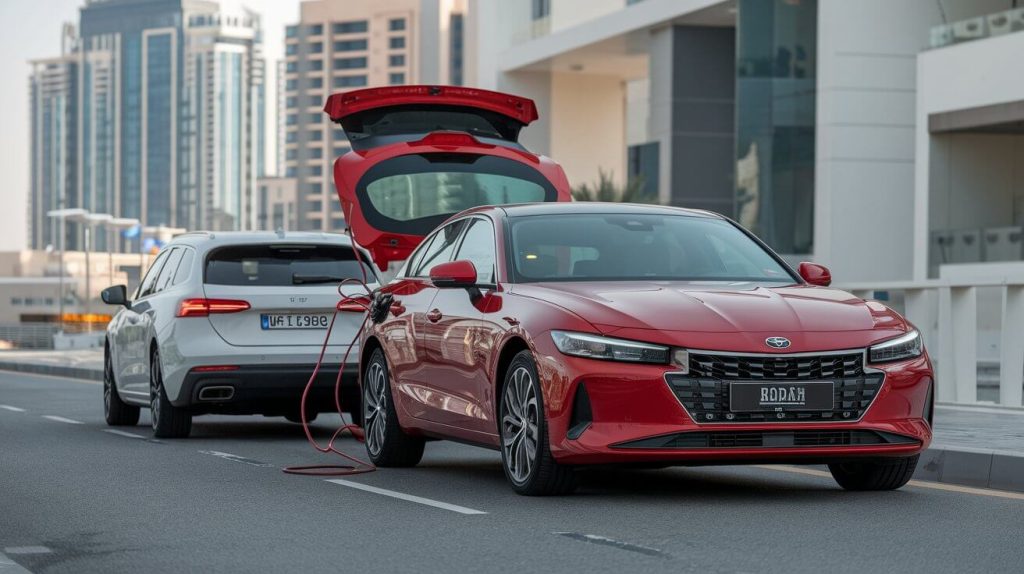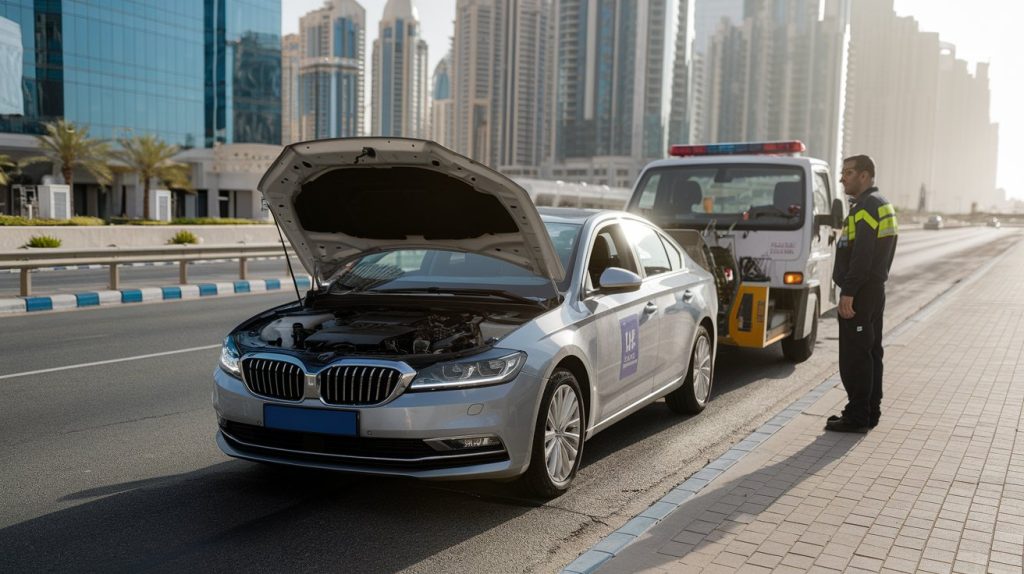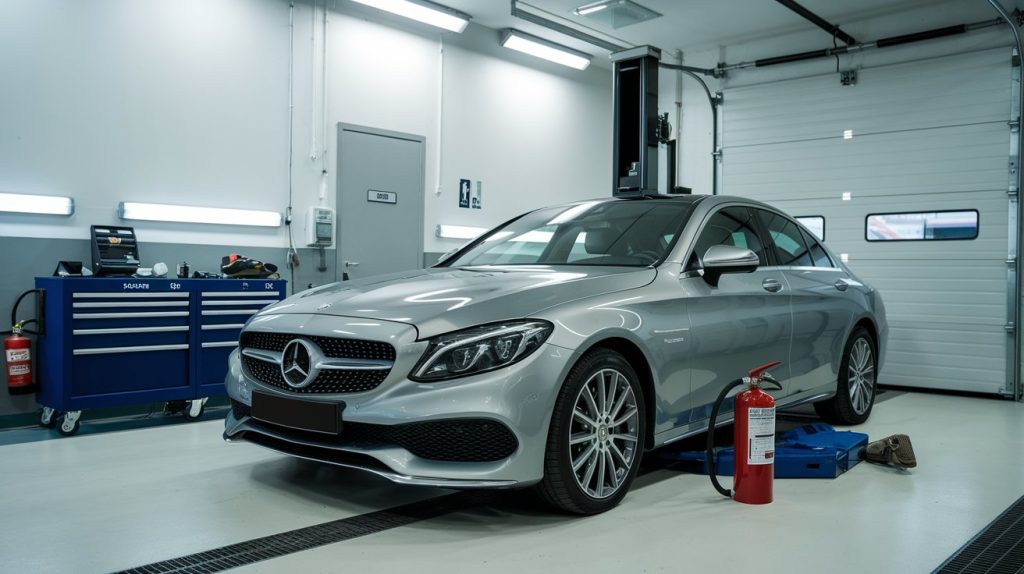Knowing how to jump-start a car is a crucial skill for every driver. Imagine being stuck with a dead battery in the middle of nowhere. A quick jump start can save your day. It’s not just about convenience; it’s about safety too. Many drivers face this issue during extreme weather or when they accidentally leave the lights on. Understanding this process can keep you prepared and confident on the road.
Why Do Batteries Die?
Car batteries can die for several reasons. Understanding these can help prevent unexpected breakdowns.
- Leaving lights on when the car is off.
- Extreme temperatures, both hot and cold.
- Old batteries lose their ability to hold a charge.
- Short trips that don’t allow the battery to recharge.
- Issues with the car’s charging system.
Knowing these common causes can help you maintain your car battery better and avoid inconvenience
Essential Tools for Jump Starting a Car
Having the right tools to jump start a car is crucial. These tools make the process safe and efficient.

- Jumper Cables: Jumper cables are the most important tool. They connect your dead battery to a live one. Make sure they are long enough and in good condition. Thick, high-quality cables are better for conducting electricity. Always check the clamps for any signs of wear or rust. Here is the best Car Battery in UAE.
- Second Vehicle: You need another car with a working battery. This vehicle will provide the power needed to start your car. Position the cars close enough for the jumper cables to reach. Ensure both vehicles are turned off before connecting the cables.
- Safety Gear: Safety gear is important. Wear gloves to protect your hands. Goggles can protect your eyes from sparks. Safety first can prevent accidents during the jump start process. Make sure to work in a well-ventilated area to avoid inhaling any harmful fumes.
- Portable Jump Starter (Optional): A portable jump starter can be handy. It doesn’t require another vehicle. These devices are compact and easy to use. Make sure it’s fully charged before you need it. Many portable jump starters also have additional features like air compressors and flashlights.
- Battery Tester (Optional): A battery tester can check the health of your battery. It helps you know if the battery is the real issue. Regular testing can prevent unexpected battery failures. It’s a simple tool that provides quick, accurate readings.
Having these tools ready can make jump starting your car quick and safe. Be prepared and keep these items in your car.
Safety Precautions for Jump Starting a Car
Jump starting a car can be risky if not done correctly. Follow these safety tips to keep yourself and your car safe.
Initial Checks:
- Inspect the Batteries: Before you begin, check both batteries for damage or leaks. If you see any cracks or corrosion, do not proceed. Leaking batteries are dangerous and should be replaced immediately.
- Ensure Vehicles are Not Touching: Make sure the cars are not touching each other. This prevents electrical problems. Position the cars so the jumper cables can reach both batteries easily.
Personal Safety:
- Turn Off Electrical Components: Turn off all electrical components in both cars including lights, radios, and air conditioning. This reduces the risk of electrical surges.
- Wear Safety Gear: Always wear gloves and goggles. Gloves protect your hands from sparks and battery acid. Goggles shield your eyes from potential battery bursts.
Environmental Considerations:
- Work in a Safe Area: Make sure you are in a well-ventilated area. Avoid jump starting the car in enclosed spaces to prevent inhaling harmful fumes. If possible, move the car to a safer location before starting the process.
- Weather Conditions: Be careful in extreme weather conditions. Rain or snow can make the ground slippery, increasing the risk of accidents. If possible, wait for better conditions before attempting to jump start your car.

Following these safety precautions helps make the jump starting process safer and more effective. Always put safety first when dealing with car batteries.
Step-by-Step Guide to Jump Starting a Car
Knowing how to jump start a car can save you from being stranded. Follow these steps to get your car running again safely.
Positioning the Vehicles:
- Align the Cars: Park both cars facing each other. Make sure they are close enough for the jumper cables to reach but not touching.
- Engage the Parking Brakes: Ensure both cars are in park or neutral. Set the parking brakes to keep them stationary.
Connecting the Jumper Cables:
- Attach the Red Clamp: Start with the dead car. Attach one red clamp to the positive (+) terminal of its battery.
- Connect to the Working Battery: Attach the other red clamp to the positive (+) terminal of the working battery.
- Attach the Black Clamp: Connect one black clamp to the negative (-) terminal of the working battery.
- Ground the Connection: Attach the remaining black clamp to an unpainted metal surface on the dead car. This can be a bolt or bracket away from the battery.
Starting the Vehicles:
- Start the Working Car: Turn on the engine of the working car. Let it run for a few minutes to charge the dead battery.
- Start the Dead Car: Try to start the dead car. If it doesn’t start, wait a few more minutes and try again.
Disconnecting the Jumper Cables:
- Remove the Black Clamps: Start by removing the black clamp from the metal surface on the dead car. Then, remove the black clamp from the negative terminal of the working battery.
- Remove the Red Clamps: Next, remove the red clamp from the positive terminal of the working battery. Finally, remove the red clamp from the dead car’s battery.
After Jump Starting:
- Let the Car Run: Keep the engine running for at least 30 minutes. This allows the battery to recharge.
- Drive Around: If possible, drive the car for a bit to ensure the battery gets a good charge.
Jump starting a car is a useful skill that can save you time and stress. Following these steps carefully can help you get back on the road safely.
Troubleshooting Common Car Jump Starting Issues
Sometimes, jump starting a car doesn’t go as planned. Here’s how to handle common issues that might arise.

Car Doesn’t Start:
- Check the Connections: Ensure all clamps are securely attached. Loose connections can prevent the current from flowing.
- Wait and Try Again: If the car doesn’t start immediately, wait a few minutes. Let the dead battery charge a bit more.
- Check the Battery: If the car still won’t start, the battery might be too damaged. It may need replacement.
No Click When Turning the Key :
- Inspect the Clamps: Make sure the clamps are on clean, unpainted metal. Corrosion or paint can block the connection.
- Jiggle the Clamps: Sometimes, adjusting the clamps slightly can improve the connection.
Engine Starts But Dies Quickly:
- Rev the Engine of the Working Car: Increase the RPMs slightly on the working car. This can send more power to the dead battery.
- Keep Trying: If the car starts but then dies, try again. The battery may need more time to charge.
Persistent Electrical Issues:
- Check for Corrosion: Corroded terminals can block the flow of electricity. Clean them if necessary.
- Test the Alternator: If jump-starting works but the battery keeps dying, the alternator might be faulty. It’s responsible for charging the battery while driving.
Additional Troubleshooting Tips:
- Listen for Sounds: A clicking sound usually means the starter is working but the battery is too weak. Silence might indicate a connection issue.
- Use a Battery Tester: A battery tester can quickly tell you if the battery is the problem. It checks the charge and health of the battery.
- Check the Fuses: Sometimes, a blown fuse can cause starting issues. Inspect and replace any blown fuses.
Understanding these troubleshooting steps can help you resolve issues when jump-starting your car. If problems persist, it might be time to seek professional help. Please also read about the Top Chinese Car Brands in Dubai.
Keeping Your Car Battery in Good Condition
Proper maintenance can extend the life of your car battery. Follow these tips to keep your battery in top shape.
Regular Checks:
- Inspect the Battery: Look for signs of damage, such as cracks or leaks. Check for corrosion around the terminals. If you notice any issues, address them immediately.
- Test the Battery: Use a battery tester to check the charge regularly. This helps you catch potential problems early.
Secure the Battery:
- Check the Battery Hold-Down: Ensure the battery is securely fastened. A loose battery can cause damage to the terminals and connections.
- Tighten the Clamps: Make sure the clamps are tight and secure. Loose clamps can lead to connection issues.
Keep the Battery Charged:
- Drive Regularly: Regular driving helps keep the battery charged. Short trips don’t allow the battery to fully recharge, so take longer drives occasionally.
- Use a Battery Maintainer: If you don’t drive often, use a battery maintainer. It keeps the battery charged without overcharging it.
Cleaning the Terminals:
- Remove Corrosion: Clean the terminals with a mixture of baking soda and water. Use a wire brush to scrub away any buildup. Rinse with clean water and dry thoroughly.
- Apply Protective Grease: After cleaning, apply a thin layer of petroleum jelly to the terminals. This prevents future corrosion.
Monitor Fluid Levels:
- Check the Electrolyte Levels: For batteries with removable caps, check the fluid levels regularly. If they are low, add distilled water to cover the plates.
- Avoid Overfilling: Only add enough water to reach the recommended level. Overfilling can cause overflow and damage the battery.
Protect from Extreme Temperatures:
- Park in a Garage: If possible, park in a garage to protect the battery from extreme temperatures. Both heat and cold can shorten battery life.
- Use a Battery Blanket: In very cold climates, consider using a battery blanket. It helps keep the battery warm and functioning properly.
Signs of a Failing Battery
- Slow Engine Crank: If the engine cranks slowly, the battery may be weak. Test it to see if it needs replacing.
- Dim Lights: Dim headlights can indicate a failing battery. Check the battery if you notice any changes in light brightness.
- Dashboard Warning Light: Many cars have a dashboard light that indicates battery problems. Don’t ignore this warning.

Proper battery maintenance ensures your car starts reliably. Regular checks and simple care steps can help avoid unexpected breakdowns.
Knowing When to Seek Professional Help
At Auto Repair UAE, we understand that car battery issues can be frustrating. Sometimes, it’s best to seek professional help to ensure your car is running smoothly and safely. Here’s when you should bring your car to us.
Persistent Starting Problems
- Car Won’t Start Consistently: If your car struggles to start even after a jump start, it’s time to visit us. This could indicate a deeper issue with the battery or the electrical system.
- Frequent Jump-Starting: If you find yourself jump-starting your car frequently, the battery might be failing. Let our experts diagnose and solve the problem.
Battery Warning Light
- Dashboard Indicator: If your battery warning light comes on, don’t ignore it. It’s a sign of trouble. Bring your car to Auto Repair UAE, and we’ll check it out immediately.
Unusual Battery Behavior
- Rapid Discharge: If your battery drains quickly without any apparent reason, it’s a sign of a problem. Our professionals can check for parasitic drains or other issues.
- Swollen Battery Case: A swollen or bloated battery case often indicates overheating or internal damage. Let us replace it for you to prevent further issues.
Corroded or Damaged Terminals
- Severe Corrosion: Severe or recurring corrosion needs professional attention. We can clean or replace the terminals as needed.
- Damaged Connectors: Broken or damaged battery connectors can cause poor performance. Our team can repair or replace these parts safely.
Electrical System Issues
- Alternator Problems: If the alternator isn’t charging the battery properly, it can lead to frequent battery failures. We can test and replace the alternator if needed.
- Faulty Wiring: Damaged or faulty wiring can cause battery problems. Our experts have the tools to diagnose and fix these issues.
Battery Replacement
- Old Battery: If your battery is more than three years old, it might be time for a battery replacement. We can recommend the best battery for your car and install it correctly.
- Unsure About Installation: Installing a new battery involves handling heavy equipment and dealing with electrical components. Let us ensure the installation is done safely and correctly.
Regular Maintenance
- Scheduled Check-Ups: Regular professional check-ups can catch potential problems early. This includes checking the battery, charging system, and overall vehicle health.
- Preventive Measures: We provide advice and perform maintenance to prevent future battery issues. This includes cleaning terminals, checking connections, and testing the battery’s health.
At Auto Repair UAE, we are here to help with all your car battery needs. Don’t hesitate to consult our experts if you encounter any issues. Our goal is to keep your car running smoothly and safely. Please also read about the sluggish car acceleration fix.
Debunking Common Myths About Jump Starting
Jump-starting a car is often misunderstood. Let’s clear up some common myths to ensure you’re well-informed.

Any Jumper Cables Will Do
- Truth: Quality Matters: Not all jumper cables are the same. Thin, low-quality cables can be dangerous. Use thick, high-quality cables for safety and effectiveness.
Can’t Jump Start in the Rain
- Truth: Take Precautions: You can jump start a car in the rain if you’re careful. Keep the cables and connections dry. Handle everything with care to avoid risks.
New Battery Doesn’t Need Maintenance
- Truth: Check Regularly: Even new batteries need regular checks. Clean the terminals, look for corrosion, and test the charge to keep the battery in good condition.
Jump Start Fully Charges the Battery
- Truth: Temporary Fix: Jump starting provides a temporary charge. It’s enough to start the car, but the battery needs a full recharge. Drive for at least 30 minutes or use a battery charger.
Jump Starting Can Damage Your Car
- Truth: Safe If Done Right: Jump starting is safe with the correct procedure. Ensure secure connections and use proper equipment to avoid damage.
Batteries Last Forever
- Truth: Limited Lifespan: Car batteries typically last three to five years. Regular maintenance can extend their life, but they all eventually need replacement.
Jump Starting Drains the Good Battery
- Truth: Minimal Impact: Jump starting uses some power from a good battery, but it’s minimal. The donor car’s alternator compensates when the engine is running.
All Battery Problems Require Replacement
- Truth: Some Issues Are Fixable: Not all battery issues mean a new battery is needed. Cleaning terminals, tightening connections, or recharging can often fix the problem.
Disconnecting the Battery Resets the Car’s Computer
- Truth: Be Cautious: Disconnecting the battery can reset the car’s computer, but it might also erase important settings. It’s better to use a diagnostic tool for resets.
Knowing these truths can help you manage your car battery better and handle jump starting safely. If you’re ever unsure, consult a professional for advice.
How to Choose the Right Battery for Your Car
Selecting the right battery is crucial for your car’s performance. Here’s a detailed guide to help you make the best choice.
Understand Your Car’s Requirements
- Check the Owner’s Manual: The manual provides the specifications for your car’s battery. It includes the required size, type, and power rating.
- Battery Group Size: Ensure the battery fits your car’s tray. Group size refers to the battery’s physical dimensions. Common sizes include 24, 35, 48, and 65.
Know the Battery Types
- Lead-Acid Batteries: These are the most common and affordable. They require regular maintenance and have a shorter lifespan.
- Absorbent Glass Mat (AGM) Batteries: AGM batteries are more expensive but offer better performance. They are maintenance-free and have a longer lifespan.
- Lithium-Ion Batteries: These are lightweight and efficient. They are more expensive and typically used in high-performance vehicles.
Consider the Climate
- Cold Cranking Amps (CCA): If you live in a cold climate, choose a battery with a high CCA rating. It indicates the battery’s ability to start the car in cold temperatures.
- Reserve Capacity (RC): RC indicates how long the battery can run the car’s electrical system if the alternator fails. Higher RC is better for extreme weather conditions.
Check the Warranty
- Warranty Period: Look for batteries with a long warranty period. It indicates the manufacturer’s confidence in their product.
- Free Replacement Period: Some warranties offer free replacement if the battery fails within a certain period. This is an added advantage.
Brand and Quality
- Reputable Brands: Choose batteries from well-known brands. They usually offer better quality and reliability.
- Quality Certifications: Check for certifications like ISO. They ensure the battery meets specific quality standards.
Installation and Maintenance
- Professional Installation: It’s best to have the battery installed by a professional. They ensure proper connections and can check the car’s charging system.
- Maintenance Needs: Some batteries require regular maintenance, like checking water levels. Choose one that fits your maintenance preference.
Price Considerations
- Cost vs. Value: Don’t just go for the cheapest option. Consider the overall value, including lifespan, performance, and warranty.
- Budget: Set a budget but be flexible. Sometimes spending a bit more can get you a significantly better battery.
Recycling the Old Battery
- Proper Disposal: Batteries contain harmful chemicals and should be disposed of properly. Many places offer recycling programs.
- Recycling Benefits: Recycling helps protect the environment and can sometimes earn you a discount on your new battery.
Choosing the right battery ensures your car runs smoothly and efficiently. By considering these factors, you can make an informed decision and avoid future issues.
Knowing how to jump start a car is essential for every driver. It can save you time and stress when your battery dies unexpectedly. Remember the key steps: position the cars correctly, connect the jumper cables in the right order, and ensure safety throughout the process. Practicing these steps safely can prevent accidents and damage. At Auto Repair UAE we offer expert services for all your battery-related needs, from testing and maintenance to replacement. Visit us for reliable, professional help to keep your car running smoothly.
